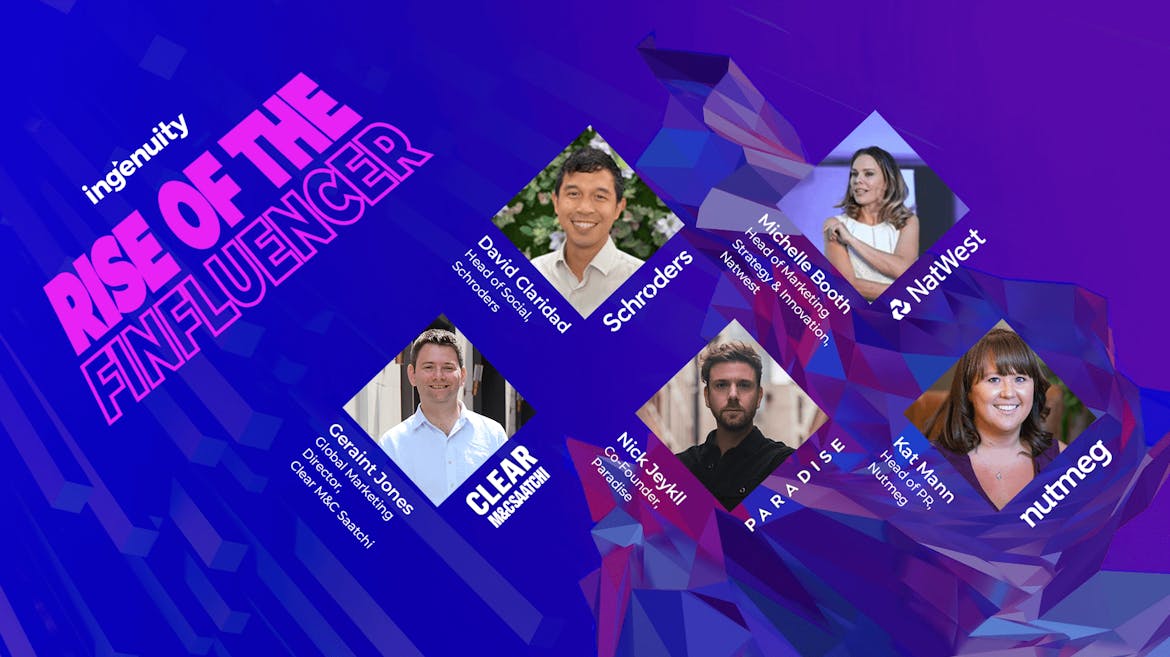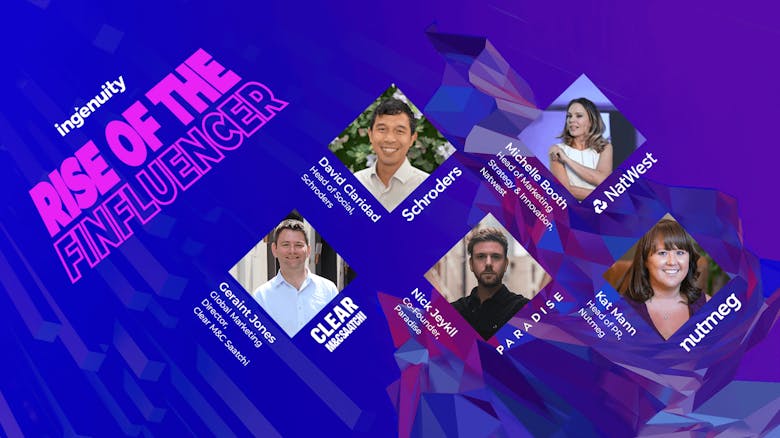
Rise of the Finfluencer: top takeaways for any FS brand looking to leverage influencer marketing
There’s a bit of an elephant in the room when it comes to the playing field of influencer marketing in the financial services space. As global marketing director Geraint Jones from Clear M&C Saatchi stated, it’s not level. Financial services brands are competing for attention on social feeds with sectors that are deemed far more exciting by the consumer – think lifestyle and fashion.
In last week’s roundtable discussion, contrary to popular belief, we learnt that consumers on social are absolutely holding conversations about money. Phrases such as ‘skint’ and ‘payday’ are in equal ranking to conversations around relationships.
The topics, however, aren’t necessarily articulated in the way that a brand in the financial services space may want to discuss them. Very few people are talking about current accounts and overdraft debt. So, there’s a need from brands in FS to join, and create the conversation in a colloquial way that doesn’t dilute or detract from the detail of the topic itself.
Education and duty of care
Major players in the financial services space want to educate audiences on things like their financial confidence and financial future. There’s also an overarching duty of care to ensure users of their products are safe and secure in the choices that they make. Michelle Booth, head of marketing strategy & innovation at NatWest reminded us that often in banking terms, explaining the benefits and risks of FS products can be a one-way ticket to snooze Ville; but, perhaps there’s something to be said for the way in which unregulated FS businesses such as crypto and buy-now-pay-later are approaching and educating their audiences. Cue Influencer marketing.
Influencer marketing in FS: key considerations
Whether it’s knowing how to articulate to key stakeholders why a piece of activity in the influencer marketing space is right for your brand, or whether the content is right for the audience you’re trying to reach, knowing your audience is crucial.
But what are key considerations when approaching influencer marketing in the financial services space? Last week Geraint (Clear M&C Saatchi), Michelle (NatWest), Kat Mann, head of PR and savings and investment specialist at Nutmeg alongside David Claridad, head of social at Schroders and Nick Jekyll co-founder at Paradise took 200+ brands (and me) on an all-things-influencer-and-finance journey. Here are my top 5 key takeaways from that roundtable aptly titled, Rise of the Finfluencer.
1. Influencer storytelling is credible and trustworthy in a world of misinformation
Michelle (NatWest) explained in an age of misinformation, often big banks try to kill their consumers with facts. She went on to say that ‘the truth of it is, we need to understand and use behavioral psychology and decision-making biases, in our favour. As a big bank we see the outcome of some of those bad decisions, that may or may not be based on misinformation. If we can start to evidence a story and bring that to life via real people – influencers – in the right way, there’s a level of truth that personalization brings. Numbers don’t do it. Stories do.’
Social media by its very nature and evolution attracts young people en masse. Michelle reminded us that ‘being young means you’ve got a higher risk of tolerance because life hasn’t battered you yet. If you’ve grown up in a boom and a bubble and not yet experienced any sort of financial crisis, be it at a macro or micro level, perhaps you don’t know the impacts that something like going bankrupt or debt management can have. It’s our job to talk about risk via stories without pushing people into a corner. We must always, however, allow people to make their own informed choices and that’s where influencers can come into their own. They’re seen as trustworthy and credible in a world of misinformation.’
2. Pick the right partners who have a genuine interest or attachment to your product or service
Geraint (M&C Saatchi) made an interesting point, that there’s an evolution in the financial journey that means we’re starting to see this ‘financial coach’ tone of voice from FS brands. There are brands connecting with audiences and imparting useful knowledge in the right way. Kat Mann (Nutmeg) said that ‘picking the right partner will vary from company to company and will also vary on the type of campaign you’re considering. Is it an educational campaign that people need to take away information from or is it an ad partnership? We often start with previous activity when on the hunt for the right partner; it’s socially acceptable to stalk your influencers, figure out if their audience is engaged – a big audience doesn’t always mean an engaged audience.
‘Then it’s about choosing a partner who will have a genuine interest or attachment to the topic for cut through. At Nutmeg, our first bit of influencer activity happened by mistake. She was a customer that happened to do a post on her Nutmeg ISA which had an amazing response. It did so well in fact she was sitting on a mountain of questions to answer so she got in touch, and we helped her answer them.’
Genuine engagement and alignment with your brand and using your brand day to day in the consumers position helps. Someone who’s used the product or service in question and seen the benefits first-hand.
3. Put emphasis on making the right content
David Claridad (Schroders) reminded us that the need to partner with the right person is perhaps secondary to the content itself.
‘People in the social media world think about perfectly matched influencers and viral content. Not everything’s going to go viral, but Tik Tok’s algorithm is a game changer. It allows you to find the best piece of content, at any one time, across all channels – if it’s something Tik Tok deems you’d be interested in.’
He continued ‘FS brands have got to use that to their advantage. The content you’re creating needs to be the right content, contextual to the channel it lives on. It doesn’t have to be what it used to be in terms of user generated content or community building. You can use Instagram reels or Tik Tok videos to build your brand and messaging without mass participation. A lot of effort should go into choosing the influencer that’s right for you and your brand but put equal emphasis, or arguably more emphasis on the content you’re creating.’ That’s the right recipe for amplification. It must be right for your brand.
4. Ensure your surrounding media mix and tone of voice fits your influencer activity
The brand fit with the influencer must echo the values your brand upholds. Nick (Paradise) told us that there are 4 key components to any influencer activity. The creative, the style of communication, the strategy – establishing the why – and the surrounding media mix. He continued ‘In terms of the creative itself and the storytelling nature of how you approach influencer content, make it more relatable and digestible for a viewer. But your surrounding media mix and tone of voice has to fit whatever you’re doing from a partnership perspective on social media. Nail your brand fit before you outreach. Make it add up by assessing the rest of your media mix.’
5. Connect to the genuine need of the consumer
Michelle (NatWest) quite rightly said the devil often has the best tunes and if you look at what crypto and buy-now-pay-later have done, they’ve attached to need and fun. Crypto is often seen as an extension of gaming – in-game currency – and has connected to the need of the modern-day gamers who are already spending digital currency. Equally, BNPL has very much played into the world of fashion and trends and again, the need to keep up. Michelle went on to say, ‘we can learn a lot from the way particular FS products have engaged with their audiences but there’s also a duty of care that goes beyond engagement and sharing, explaining the challenges around regulation and risk. Most financial decisions happen before the age of 35, so there’s a real opportunity to capture that audience. Money is the enabler to people’s needs, hopes and dreams; people will make a lifetime loyalty play based on early engagement; but there’s an education piece that’s missing. If we learn how to connect to the need of the person on the other side and do so in the right way – with the right influencer and the right content that’s relevant to your brand the story you’re trying to tell – it starts to stick.’
And there you have it! My key takeaways from last week’s roundtable: Rise of the Finfluencer. Special thanks to our host Geraint from M&C Saatchi Group, guest speakers Michelle from NatWest, Nick from Paradise, Kat from Nutmeg, David from Schroders and the 200+ brands that tuned in to hear their genius. Finally, thanks to the behind the scenes team at Ingenuity.
If you’re interested in learning more about this topic feel free to get in touch at james.brown@ingenuitylondon.com. And, we’ll be back in Q1 / 2022 with more discussions around the Finfluencer.
Subscribe to Ingenuity’s content hub
Receive the latest interviews, insights and trends straight to your mailbox.

